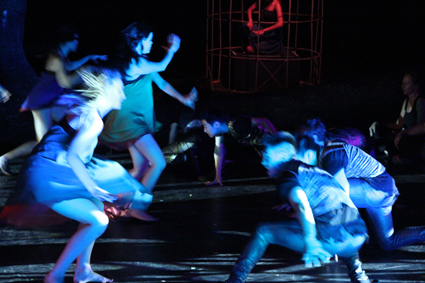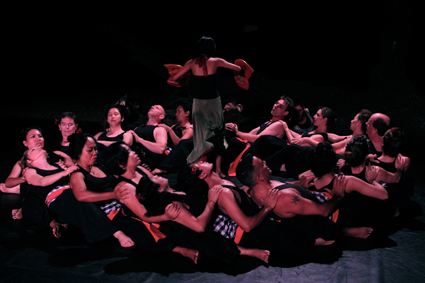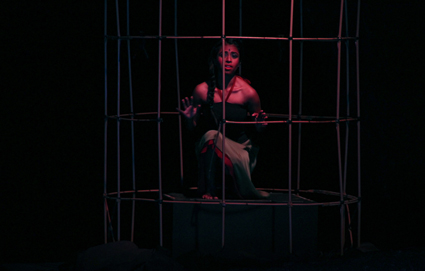 |
Zombies in the Banyan Tree, Tracks Dance Company photo Jess Devereux |
A lone musician appears in the fading light of dusk, seats himself centre stage at a bamboo gamelan and begins to play. The audience is hushed, drawn into the rhythm of the gamelan and the surrounding sounds of the approaching night.
Integral to this production are the live beats and myriad sounds of traditional Balinese music, Kecak choir and Beat Boxer K-Fuzz. Placing live musicians directly into a dance or theatre work allows a relationship to build between performers and music. Rather than simply waiting for the next beat to fall, musicians and dancers have the opportunity to respond to each other, creating a tight link and potentially strengthening the power of the delivery.
 |
Zombies in the Banyan Tree, Tracks Dance Company photo Jess Devereux |
Tracks has built a reputation on inserting dance venues into Darwin’s everyday landscape, transforming these sites from the usual to the unusual and magical. Set against two rain trees in Darwin’s George Brown Botanical Gardens, the obvious question arose: “Where’s the Banyan?” Despite Artistic Director Tim Newth’s best laid plans, the banyan he had sited the work around was cut down and removed just weeks before opening night, highlighting just one of the many challenges to creating your own venue.
 |
Zombies in the Banyan Tree, Tracks Dance Company photo Jess Devereux |
The concept of seemingly opposite forces and their interconnection in the natural world is a strong theme in Balinese culture and this theme was woven through the performance. From the black and white check of the Kecak performers’ costumes to the same pattern on the floor of the set, to contemporary and traditional cultural forms being presented side by side, the sense of yin and yang was constantly reinforced.
The Butterflies, all female, wore dramatically bright makeup, airy dresses and flapped intricately designed handheld wings. In contrast, the Zombies, predominantly male, wore muted colours of black and grey and lurked in the protection of the rain tree. This central theme of opposition was, however, at times compromised causing conflicting emotional responses.
We were set up to feel sympathy for the Butterflies as one of their community was dragged from the stage by the Zombies, her wings violently plucked. This damaged Butterfly spent most of the remainder of the performance caged. Yet as the Zombies and Butterflies clashed in battle, and the Zombies began to show dominance, audience members cheered the squelchingly gory deaths of the Butterflies. A mix of graphic sound effects and cheeky choreography had brought the audience to the side of the Zombies.
In such a dark piece, it was curious to see humour introduced at such a late stage. Once again I felt conflicted when Michael Jackson’s “Thriller” made a fleeting appearance and when some of the more grotesque moments were suddenly made light of with humorous sounds or gestures.
The Kecak choir is the centerpiece of Zombies in the Banyan Tree and is another artistic form drawn directly from traditional Balinese culture. Perhaps made most famous by its appearance in the 1992 film Baraka, the Kecak choir works its way to a state of frenzied trance through rhythmically mechanical chanting and unison movement. Led by Balinese dancer Desak Putu Warti and her brother I Dewa Putu Sudiantara, the choir was made up of local community members who had answered a general call-out to take part.
The Kecak choir represents two areas of particular interest shown by Tracks’ Artistic Directors—the involvement of the general community in their shows and the incorporation of elements drawn from a variety of cultures represented locally. While I understand the philosophy to explore and create work that speaks about the community in which we live, this performance left me wondering about the introduction of a complex cultural form to untrained performers in such a direct translation. I waited excitedly for the Kecak choir, and the work, to build to its predicted climax, only to find that it never arrived. For me this poses the question—in order to make the work their own, how does an artist overcome expectations like mine when using a well-known cultural form?
Moments of this performance will remain with me: Putu’s wailing lament drew a bleak yet beautiful image and the vocal flexibility of K-Fuzz sustained the performance. Zombies Under the Banyan Tree reminded me just how culturally rich this community I live in really is.
Tracks Dance Company, Zombies in the Banyan Tree, concept, direction David McMicken, Tim Newth, choreographers Desak Putu Warti, Jessica Devereux, Nick Power, musicians I Dewa Putu Sudiantara (Bali), Megan Atfield, Desak Putu Warti, Michael Koufos (K-Fuzz), George Brown Botanic Gardens, Darwin, Aug 9-20
The NT Writers’ Centre’s RealTime Workshop project is supported by the Australian Government Regional Arts Fund and the Northern Territory Government.
Fiona Carter began her professional career as a classical musician and, after studying and working in the UK, returned to Australia to work as an arts manager based in Darwin. She is passionate about art created in the Northern Territory and South East Asia.
RealTime issue #117 Oct-Nov 2013 pg. web
© Fiona Carter; for permission to reproduce apply to [email protected]








 back
back